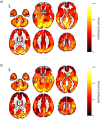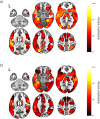Virtual lesions in MEG reveal increasing vulnerability of the language network from early childhood through adolescence
- PMID: 37951971
- PMCID: PMC10640569
- DOI: 10.1038/s41467-023-43165-7
Virtual lesions in MEG reveal increasing vulnerability of the language network from early childhood through adolescence
Abstract
In childhood, language outcomes following brain injury are inversely related to age. Neuroimaging findings suggest that extensive representation and/or topological redundancy may confer the pediatric advantage. Here, we assess whole brain and language network resilience using in silico attacks, for 85 children participating in a magnetoencephalography (MEG) study. Nodes are targeted based on eigenvector centrality, betweenness centrality, or at random. The size of each connected component is assessed after iterated node removal; the percolation point, or moment of dis-integration, is defined as the first instance where the second largest component peaks in size. To overcome known effects of fixed thresholding on subsequent graph and resilience analyses, we study percolation across all possible network densities, within a Functional Data Analysis (FDA) framework. We observe age-related increases in vulnerability for random and betweenness centrality-based attacks for whole-brain and stories networks (adjusted-p < 0.05). Here we show that changes in topology underlie increasing language network vulnerability in development.
© 2023. The Author(s).
Conflict of interest statement
The authors declare no competing interests.
Figures







References
Publication types
MeSH terms
Grants and funding
LinkOut - more resources
Full Text Sources

